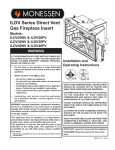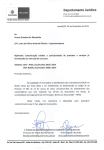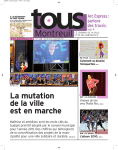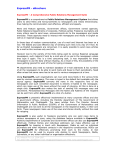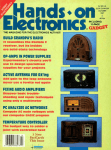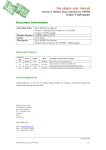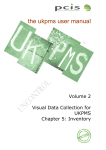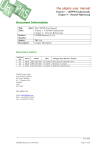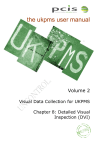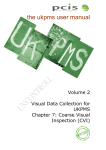Download the ukpms user manual
Transcript
the ukpms user manual Volume 2 Visual Data Collection for UKPMS Chapter 9: Footway Network Survey (FNS) the ukpms user manual Volume 2: Visual Data Collection for UKPMS Chapter 9: Footway Network Survey (FNS) Document Information Title (Sub Title) Product Number Authors Description The UKPMS User Manual Volume 2: Visual Data Collection for UKPMS Chapter 9: Footway Network Survey (FNS) UKPMS Manual March 2010 Andy Pickett and Andrew Gallagher This chapter describes the UKPMS Footway Network Survey (FNS) and is intended for the information of UKPMS users and UKPMS system developers Document History Version No Status Author 01 02 03 04 05 06 07 Draft Final Review Review Final Draft Revised JW JW KAG CB ME KAG KAG Date July 2009 August 2009 16 Oct 2009 20 Oct 2009 30 Oct 2009 05 Jan 2010 02 Mar 2010 Changes from Previous Version First draft for internal review Release version for external comment Internal review and comment Technical review and comment Final for release Incorporating TN48 text Amendments following review PCIS Support Contractor TRL Crowthorne House Nine Mile Ride Wokingham Berkshire RG40 3GA www.pcis.org.uk Email: [email protected] Phone: +44 (0)1344 770480 Fax: +44 (0)1344 770356 UKPMS Manual_02_09v07.doc March 2010 Page 2 of Chapter 9 the ukpms user manual Volume 2: Visual Data Collection for UKPMS Chapter 9: Footway Network Survey (FNS) Contents 1 2 3 4 5 6 7 8 9 Introduction ....................................................................................................................... 4 Context ................................................................................................................................ 6 Overview of FNS Survey Procedure .............................................................................. 7 Processing FNS in UKPMS ...........................................................................................12 Using the FNS for Reporting Performance.................................................................17 Accreditation to Support FNS .......................................................................................27 Frequently Asked Questions ..........................................................................................28 Detailed FNS Listing.......................................................................................................29 FNS Defect Definitions and Photographs ..................................................................31 UKPMS Manual_02_09v07.doc March 2010 Page 3 of Chapter 9 the ukpms user manual Volume 2: Visual Data Collection for UKPMS Chapter 9: Footway Network Survey (FNS) 1 Introduction The Footway and Cycletrack Management Group (FCMG) has developed the Footway Network Survey (FNS) to meet local authorities’ need for a comprehensive survey of the condition of their footway networks to support effective asset management. This document gives an overview of the new survey for users. In summary, the survey is a continuous survey. The inspector reports the condition of the footway in one of four condition levels. The levels are: 1. As new (AN) (condition level 1) 2. Aesthetically impaired (AI) (condition level 2) 3. Functionally impaired (FI) (condition level 3) 4. Structurally unsound (SU) (condition level 4) The four condition levels reported for FNS have been defined to ensure broad consistency with the other UKPMS footway surveys, CVI and DVI. The UKPMS FNS is intended to enable comparatively rapid assessment of the condition of the footway network, compared with a more detailed DVI survey, by assessing a limited range of broadly defined defects, and by optionally recording “lateral” extents, rather than measurements of defect dimensions. It is intended to give a more comprehensive assessment of the condition of the footway network, compared with a driven or walked CVI survey, by continuously recording the condition of the footway, and with an additional category of defect, Aesthetic Impairment. It is intended that the FNS is used as a network condition tool to identify where more detailed information may be required to support and validate treatment decisions and scheme identification; it may also be used on a cyclical basis to identify those parts of the network where more detailed assessment is required. The FNS records measured lengths. The FNS is variable chainage-related, i.e. the lengths of a feature which are affected by a defect (are in a condition level) are defined by the actual start and end chainages. The FNS is also sectionrelated, which means that for any given defect the maximum defect length that can be recorded is the length of the section. There are four possible variants of the FNS. Users should be aware that, as currently specified within UKPMS, the results from the four variants are NOT INTERCHANGEABLE or DIRECTLY COMPARABLE. The four variants are compared in Table 9.1: UKPMS Manual_02_09v07.doc March 2010 Page 4 of Chapter 9 the ukpms user manual Volume 2: Visual Data Collection for UKPMS Chapter 9: Footway Network Survey (FNS) • • • • The basic survey. (The basic survey is a simple linear survey, where condition levels are collected continuously along a footway, but pavement type is not collected). An enhanced survey option1. (A basic survey enhanced by the collection of pavement type) An enhanced survey option2. (A basic survey enhanced by recording the lateral extent of condition, but pavement type is not collected) An enhanced survey option3. (A basic survey enhanced by recording both the lateral extent of condition, and the pavement type) Table 9.1 Comparing variants of the Footway Network Survey Footway Network Without lateral extents Survey VARIANTS Unrecorded pavement basic survey type Recorded pavement type enhanced survey option 1 With lateral extents enhanced survey option 2 enhanced survey option 3 The differences between the results from the four variants are explained in section 5.5. UKPMS Manual_02_09v07.doc March 2010 Page 5 of Chapter 9 the ukpms user manual Volume 2: Visual Data Collection for UKPMS Chapter 9: Footway Network Survey (FNS) 2 Context The UK Roads Board’s Footways and Cycletrack Management Group (FCMG) has developed and tested the Footway Network Survey (FNS) which is being implemented within UKPMS. The FNS is intended to be a primary condition survey of footways. Its cost-effectiveness should allow authorities to apply it to the whole of their footway network sufficiently frequently to support performance and asset management. It will also allow the assessment and targeting of maintenance schemes and help to identify where more detailed investigations may be required. Whilst the FNS does not replace the existing visual surveys within UKPMS, it is anticipated that over time the FNS will provide a more effective alternative to the CVI survey as the main network level survey of footways. Users may prefer to continue to carry out selective DVI surveys to provide more detailed information, either at locations identified as potential maintenance schemes by FNS or on high use or high priority footways. It was not been possible to carry out extensive testing of the treatment rules in time to incorporate them within UKPMS so that they are available to users in April 2010. Consequently, it is intended that they will be reviewed during 2010, in the light of maintenance practitioner experience and feedback from their application to local authority footway networks, and that an updated set of treatment rules should be produced by April 2011. The FNS is intended to: • • • • Provide a cost-effective network-level survey that can be applied on all footways. Allow users to identify those sections of the footway network that require maintenance. Include an assessment of quality of appearance of the footway, in addition to serviceability and structure. Enable reporting similar to that used for carriageways (for example red/amber/green) both as headline measures for the whole network or sub-network, and for mapping local condition. 2.1 Coverage The FCMG has recommended that, as a minimum, category 1, 1A and 2 footways should be surveyed every 2 years, and category 3 and 4 footways every 4 years. UKPMS Manual_02_09v07.doc March 2010 Page 6 of Chapter 9 the ukpms user manual Volume 2: Visual Data Collection for UKPMS Chapter 9: Footway Network Survey (FNS) 3 Overview of FNS Survey Procedure The FNS is carried out on foot and will normally be carried out by two surveyors, although it may be possible for a single surveyor to carry out the survey where local health and safety guidelines permit. As it is a walked survey, productivity is likely to be lower than of a driven CVI survey. The trials carried out as part of the development of the survey showed an increase in productivity compared with DVI surveys, with typical outputs of between 6 and 12km per day. Survey productivity will depend on a number of factors, including the experience of the surveyors, the condition of the footway and the functionality and usability of the data capture software being used. Ideally, such software would interface with recording devices that allow information on location to be recorded automatically, allowing the surveyor to rapidly “toggle” between the FNS condition categories without having to enter distance information. The FCMG has discussed the development of such hardware and software with software providers to encourage the development of such hardware and software to maximise survey productivity. Kerb defects are not included in the FNS, except to the extent to which they form part of the walking surface of a footway, in which case they should be included as part of the assessment of that footway. Surveys are designed to be carried out on a “linear” basis, by a single surveyor walking along a footway, referenced to chainages within a UKPMS section. The surveyor will normally use a continually-recording measuring wheel to determine chainage. For practical, and health and safety, reasons surveyors may choose to work in pairs, with one recording the footway on one side of the road, and another the footway on the other side. Under the FNS, the footway is categorised into one of four condition levels (or “defects”) as described in Table 9.2 below. It is intended that the survey will generally be carried out using hand-held Data Capture Devices (DCDs) and inspectors will “toggle” between the four condition levels as they traverse the footway. It is expected that this process will be facilitated within the software, in order to minimise the number of key presses and simplify the inspector’s task. Table 9.2 Footway Network Survey Condition Levels Condition Level 1. As New Description Footways that have no defects and are in essentially “as new” condition. Equivalent to “Not Defective” in CVI and DVI. UKPMS Manual_02_09v07.doc Examples Brand new or recently reconstructed footway March 2010 Page 7 of Chapter 9 the ukpms user manual Volume 2: Visual Data Collection for UKPMS Chapter 9: Footway Network Survey (FNS) 2. Aesthetically Impaired 3. Functionally Impaired 4. Structurally Unsound Lengths of footway that are in sound condition but have reduced visual attractiveness though a combination of mismatched materials and patching. No equivalent in CVI and DVI surveys. Lengths of footway with surface deterioration that are structurally sound. Equivalent to the Minor footway defects in CVI & DVI surveys. Lengths of footway with defects affecting both the surface and the structure. Equivalent to the Major footway defects in CVI & DVI surveys. Sound footways with patching Modular footways with sound bituminous patches Modular footways with elements of different colour/age/material Faded bituminous materials (especially coloured bituminous) Cracked but level flags/blocks Minor surface deterioration/fretting/fatting Cracked and/or uneven flags Major fretting and potholing Major cracking Poor shape etc. The condition levels apply to all types of footway construction, although the detailed definitions for each condition level differ by construction type. This has benefits in terms of survey simplicity and productivity (in that inspectors do not have to record changes in construction over short lengths in the basic survey). It also allows performance, condition and need for treatment to be analysed and reported independently of footway construction. Where an authority has an inventory of footway widths and construction types within UKPMS, these will be applied to the defects during processing, thus enhancing the usefulness of the condition data. Where footways are present they are always recorded as having a condition level, even where there are no defects, in which case they are recorded as being in “as new” condition. This removes the need for a basic footway inventory to be collected for analysis purposes, as was required for deriving BV187 data from DVI, and replaces the “not defective” defect within UKPMS. Codes have also been provided to allow Cycle tracks and Paved Verges to be assessed using the FNS, and are detailed in Table 9.3 below and in the Section 8 and Section 9; for this first implementation of the FNS these use exactly the same condition levels and definitions and are processed using the same rules that apply to footways. The condition level is taken as indicative of the whole footway width on the basis that, at the coarse level at which the survey is designed, the condition level will generally be consistent across a footway and in any case, except on very wide footways, treatments will generally apply to the whole width of the footway. Where condition does vary across the footway, surveyors are instructed to record the “worst” condition level that applies, on the basis that this will generally be the determinant for treatment. UKPMS Manual_02_09v07.doc March 2010 Page 8 of Chapter 9 the ukpms user manual Volume 2: Visual Data Collection for UKPMS Chapter 9: Footway Network Survey (FNS) Optionally, in an enhanced survey, using option2 or option3, for condition levels 3 (functional impairment) and 4 (structurally unsound), the extent of the width of the footway that is affected is also recorded, as 25%, 50% or 100%. 3.1 The Basic Survey For the basic survey the condition level recorded at a particular location applies to the whole of the footway width at that location. At the coarse level at which the survey is designed to operate, condition level will generally be consistent across a footway and, in any case, treatments will generally be applied to the whole width of the footway except on very wide footways. Where condition does vary across the footway, surveyors are instructed to record the “worst” condition level that applies, as this will generally determine the treatment required. Note that, although the Basic survey is carried out without recording lateral extent, these are automatically added as default extents to the survey HMDIF prior to loading the survey data to UKPMS. 3.2 Enhancements to the Basic Survey 3.2.1 Recording Pavement (Surface Construction) Type The surface construction types in the table below are those already included in the UKPMS model (as “pavement type”), and are applied as described in Table 9.3. Table 9.3 Footway pavement (surface construction) type Pavement Type Unknown Bituminous Flagged Block Paved Concrete Comprising All surface types Fully Flexible Bituminous Surface Layer (>20mm) Concrete flagstones Stone flagstone Small element flagstones, Clay Blocks Concrete Blocks Cobbles Jointed Concrete Unjointed Concrete Surface dressed/treated concrete The FNS is normally collected (in the basic survey) using the unknown pavement type; that is recording the condition levels independently of the surface construction of the footway being inspected. If a footway inventory is available within UKPMS, and if this is utilised when the FNS is processed, the rules appropriate to specific pavement types will be applied. UKPMS Manual_02_09v07.doc March 2010 Page 9 of Chapter 9 the ukpms user manual Volume 2: Visual Data Collection for UKPMS Chapter 9: Footway Network Survey (FNS) Optionally, users may record the pavement type during the survey, by recording the appropriate defect codes. In instances where the surface type of the footways varies from place to place along the section, this will have an adverse impact on survey productivity. Codes for all of the various footway surface types within UKPMS have been defined for the FNS survey to allow users to record surface construction types as part of the defect code. The descriptions of the defect codes for all of the possible pavement types supported by UKPMS are set out in Table 9.4. Table 9.4 FNS defect codes by pavement (surface construction) type Pavement Type Footway Cycle Track Defect Type Description Bituminous FBAN FBAI FBFI FBSU FCAN FCAI FCFI FCSU FFAN FFAI FFFI FFSU FKAN FKAI FKFI FKSU FUAN FUAI FUFI FUSU YBAN YBAI YBFI YBSU YCAN YCAI YCFI YCSU YFAN YFAI YFFI YFSU YKAN YKAI YKFI YKSU YUAN YUAI YUFI YUSU As New Aesthetically Impaired Functionally Impaired Structurally Unsound As New Aesthetically Impaired Functionally Impaired Structurally Unsound As New Aesthetically Impaired Functionally Impaired Structurally Unsound As New Aesthetically Impaired Functionally Impaired Structurally Unsound As New Aesthetically Impaired Functionally Impaired Structurally Unsound Concrete Flagged Block Paved Unknown Hard Paved Verge Defect Code VBAN VBAI VBFI VBSU VCAN VCAI VCFI VCSU VFAN VFAI VFFI VFSU VKAN VKAI VKFI VKSU VUAN VUAI VUFI VUSU 3.2.2 Recording Lateral extent of condition (defect) Users also have the option of recording a lateral extent as an approximation of footway width. The options for extent for the enhanced survey are set out in Table 9.5. UKPMS Manual_02_09v07.doc March 2010 Page 10 of Chapter 9 the ukpms user manual Volume 2: Visual Data Collection for UKPMS Chapter 9: Footway Network Survey (FNS) Note that, although the Basic survey is carried out without recording lateral extent, these are automatically added as default extents to the survey HMDIF prior to loading to UKPMS. Table 9.5 Lateral extent of condition (defect) Condition Level 1 2 3 4 Description Valid Extents As New Aesthetically Impaired Functionally Impaired Structurally Unsound 100% 100% 25%, 50%, 100% 25%, 50%, 100% Basic Survey Default Extent 100% 100% 86% 65% No more than one condition level may be recorded at the same location; where two or more condition levels affect the footway surveyors are required to record the worse condition level. Because the results from surveys carried out without recording lateral extent differ from surveys carried out with recording lateral extent, and because it is not possible to convert the results from one to the other within UKPMS as currently configured, local authorities are advised to adopt one or other approach consistently across the whole of their footway network. The basic survey (without recording lateral extent) has been adopted as the standardised approach to report FNS results consistently with nationally-defined condition and performance measures. UKPMS Manual_02_09v07.doc March 2010 Page 11 of Chapter 9 the ukpms user manual Volume 2: Visual Data Collection for UKPMS Chapter 9: Footway Network Survey (FNS) 4 Processing FNS in UKPMS From April 2010, processing of FNS surveys will be possible using Rules and Parameters version RP9.01 within UKPMS, to determine indicative need for treatments at a footway and network level and hence to report the results of FNS surveys When processing FNS data using the UKPMS Automatic Pass functionality it is recommended that; 1. Fixed Length Merging at a length of 100m is used. 2. The survey is not combined with other survey types. 4.1 Generating UKPMS Condition Indices using FNS The UKPMS processing logic requires Condition Indices to be defined as an input to the treatment selection process. In order to support processing of FNS using UKPMS, and to allow the treatment rules to be applied directly to the quantities of defect recorded, four condition indices have been defined with a direct, 1:1 mapping to the recorded defects (the four levels of footway condition). These are listed in Table 9.6: Table 9.6 UKPMS condition indices for FNS defects (condition levels) Condition Index Type Code FNS1 FNS2 FNS3 FNS4 Condition Index Type Description Text FNS Condition Level 1 FNS Condition Level 2 FNS Condition Level 3 FNS Condition Level 4 The Overall Condition Index is the sum of FNS3 and FNS4 over the merged length. Note that whilst it is strongly recommended that CVI or DVI data are not combined with FNS data for the same section/feature/XSP in a single processing run, in the event that this happens, the Overall Condition Index will take the highest value either as generated from FNS or from CVI/DVI. 4.2 Identifying treatments using FNS One of the main requirements for the FNS is that, in conjunction with UKPMS, it should support the identification of need for treatment, both at a network level and scheme level: • At a network level to determine the need for future investment. UKPMS Manual_02_09v07.doc March 2010 Page 12 of Chapter 9 the ukpms user manual Volume 2: Visual Data Collection for UKPMS Chapter 9: Footway Network Survey (FNS) • At a scheme level as an input to an option appraisal or value management process to determine location and design. Treatment identification rules have been defined within UKPMS Rules and Parameters version RP9.01, to determine: 1. The indicative treatment required. 2. The length or area to which that treatment applies. 3. The indicative cost associated with that treatment or scheme length. The treatment selection rules that are available within UKPMS for application to FNS data allow it to be used to generate indicative generic treatments, and associated cost estimates. They are not detailed scheme designs and costs these must be developed outside UKPMS. It is recommended that, when processing FNS data using UKPMS, the survey is not selected in combination with CVI and / or DVI surveys, but processed on its own with or without inventory as available. The generic treatments that can be generated from FNS data and the pavements types that they can be applied to are set out in Table 9.6. Table 9.6 UKPMS generic treatments from FNS surveys Concrete Block Paved Flag Bituminous Applicable Pavement Types Unknown Generic Treatment Strengthening or Renewal Resurfacing Surface Treatment Localised Treatment The UKPMS Rules and Parameters make use of Intervention Levels to specify the points at which the various condition indices, in combination, invoke treatments. These intervention levels can be varied by footway hierarchy. Table 9.7 shows the combinations of minimum intervention levels that apply for all levels within a footway hierarchy. The provisional treatment selection rules to be applied to the FNS data to generate indicative generic treatments are set out in Table 9.7. Table 9.7 also shows which surface construction types they apply to. For the length under consideration each rule line is tested against the percentage of that length in each condition level. The rules are hierarchical, in UKPMS Manual_02_09v07.doc March 2010 Page 13 of Chapter 9 the ukpms user manual Volume 2: Visual Data Collection for UKPMS Chapter 9: Footway Network Survey (FNS) that once a set of conditions is satisfied then a treatment is selected and no further consideration of the length in question takes place. This is consistent with the current approach to treatment selection in UKPMS and can be relatively easily incorporated in the UKPMS rules and parameters, which also allows the variation of the rules by surface construction (pavement type). Table 9.7 Generic treatment rules linked to intervention levels for FNS surveys ILF4 ILF5 ILF6 ILF7 ILF8 ILF9 Resurfacing Resurfacing ILF1 5 Resurfacing Surface Treatment Surface Treatment Localised Treatment Localised Treatment ILF1 0 ILF1 2 ILF1 3 ILF1 6 ILF1 7 ILF1 9 ILF2 0 Concrete Block Paved Flag ILF1 1 ILF3 Bituminous Resurfacing ILF2 Applicable Pavement Types Unknown ILF1 2 (Aesthetically Impaired) Strengthening or Renewal Strengthening or Renewal Strengthening or Renewal Strengthening or Renewal Resurfacing 3 (Functionally Impaired) Generic Treatment 4 (Structurally Unsound Intervention Levels ILF14 ILF18 ILF21 ILF2 2 ILF2 3 Table 9.8 shows the percentage length of footway with each condition values that apply for these intervention levels, depending upon the hierarchy category that a footway has been assigned to (if recorded with inventory) or to a section as a whole. UKPMS Manual_02_09v07.doc March 2010 Page 14 of Chapter 9 the ukpms user manual Volume 2: Visual Data Collection for UKPMS Chapter 9: Footway Network Survey (FNS) Table 9.8 Intervention levels for FNS surveys Intervention Level Condition Category ILF1 4 Footway Hierarchy Category 1 and 2 3 4 1a 50% 55% 60% 65% ILF2 4 30% 30% 40% ILF3 ILF4 3 4 30% 30% 30% 30% ILF5 ILF6 ILF7 3 2 4 25% 20% 30% 30% 25% 30% ILF8 ILF9 ILF10 ILF11 ILF12 ILF13 ILF14 ILF15 ILF16 ILF17 ILF18 ILF19 3 2 3 4 3 3 2 4 3 3 2 3 20% 35% 60% 5% 50% 50% 20% 20% 40% 40% 45% 101%* 20% 35% 60% 5% 50% 50% 20% 20% 40% 40% 45% 45% ILF20 3 101%* 35% ILF21 ILF22 2 4 101%* 20% 15% 20% ILD23 3 30% 30% 40% 40% 101%* 101%* Strengthening or Renewal 101%* 101%* 101%* 101%* 101%* 101%* Strengthening or Renewal 101%* 101%* 101%* 101%* 65% 65% Resurfacing 5% 5% Resurfacing 55% 55% 101%* 101%* Resurfacing 101%* 101%* 20% 20% Resurfacing 45% 45% 101%* 101%* Resurfacing 101%* 101%* 50% 50% Surface Treatment 101%* 101%* Surface Treatment 101%* 101%* 30% 30% Localised Treatment 35% 35% Localised Treatment 45% Treatment Strengthening or Renewal Strengthening or Renewal *Notes: a. Where all values for an intervention level are set to 101% for a particular hierarchy, this ensures that the associated treatment is never invoked. This is used to ensure that Aesthetic Impairment has no role in treatment selection on Hierarchy 3 and 4 footways. (The treatment selection rules are also set so that Aesthetic Impairment can never invoke a treatment without other condition categories also being present within the same treatment length). b. If a particular treatment is not used for a particular pavement type for all hierarchies then that treatment does not appear in the treatment rules for that pavement type UKPMS Manual_02_09v07.doc March 2010 Page 15 of Chapter 9 the ukpms user manual Volume 2: Visual Data Collection for UKPMS Chapter 9: Footway Network Survey (FNS) Condition Level 2 (Aesthetically Impaired) does not generate a treatment requirement on its own. On Hierarchy 1a, 1 and 2 footways, Aesthetic Impairment can generate treatments in combination with other condition levels. There is wide variation in the extent to which authorities carry out maintenance to address visual attractiveness of the street, and the treatment choices that they would apply differ widely, and potentially encompass improvement schemes that go far beyond maintenance. The same treatment rules apply to the basic survey and to the enhanced variants of the survey. 4.3 Treatment Costs UKPMS provides a mechanism for determining indicative costs based upon simple unit rates. These cost rates are not provided as part of the UKPMS Rules and Parameters, but have to be populated by users, to reflect local circumstances and contract schedules of rates that apply. The application of different treatment cost rates allows for the actual treatment specification in different locations as this would vary considerably within each generic treatment. If users have footway inventory data loaded, then the cost rates will be more accurate, as they will be based upon a more detailed assessment of the areas to be treated, and can reflect the type of footway construction. UKPMS Manual_02_09v07.doc March 2010 Page 16 of Chapter 9 the ukpms user manual Volume 2: Visual Data Collection for UKPMS Chapter 9: Footway Network Survey (FNS) 5 Using the FNS for Reporting Performance 5.1 Footway condition All versions of the FNS support reporting the percentages of the network in each condition level, using simple ad-hoc reporting tools. These are NOT defined within UKPMS, and must be specified by the User, or by the PMS supplier on behalf of the User. 5.2 Survey length and maintenance need For the purposes of defining a single standard report within UKPMS for the first implementation of the survey, the FCMG has decided that this should focus on “need for maintenance”. UKPMS Technical Note 47 describes the performance reporting that is available within UKPMS for the FNS. There are two related reports; • the first gives details of the length of FNS survey, within financial years, and • the second gives a breakdown of maintenance need based upon the FNS survey data. The “headline measure” is the percentage of the surveyed length of footway requiring major maintenance (Strengthening or Renewal or Resurfacing) as determined by the default treatment selection rules within UKPMS. It is assumed that the FNS data included in the selection criteria for the automatic pass run for the report is representative of the condition of the footway network as a whole. Users who wish to report on trends in footway condition will need to ensure a sufficiently large, representative proportion of the footway network is surveyed at sufficient frequency to support this requirement. The report has been designed so that it can be run without using inventory. If inventory is used then different (more accurate) figures will be obtained for the treatment lengths. 5.3 Processing and Reporting Requirements There is no specific requirement regarding the extent of the footway network to be covered by FNS or any restriction on the use of survey data from previous years. Users will determine their data requirements for the automatic pass used to produce the report. The report itself will indicate the extent of the network that it reports upon and the distribution of ages of the condition data. UKPMS Manual_02_09v07.doc March 2010 Page 17 of Chapter 9 the ukpms user manual Volume 2: Visual Data Collection for UKPMS Chapter 9: Footway Network Survey (FNS) 5.3.1 Automatic pass parameters The treatment rules are intended to use merge method 1 (Fixed intervals) with the interval set to 100m. However, other merge methods may also be suitable and some advanced users may wish to investigate or experiment with other settings. Users are advised to run the report using only FNS data, and other survey types should not be included in the Automatic Pass used to produce the report. For the purposes of producing the performance report, the most recent FNS survey data will be used within the survey time window selected. Users are recommended to set this to include data from the previous two years, although users can include older data if they feel that this is representative of their footway network condition when setting the survey time window. If a footway inventory is available users are advised to set the Automatic Pass used to generate the report to make use of the inventory data. However, the report can also be run without inventory using the “default” settings: • Merge method: 1. (100m fixed intervals) • Survey Type: FNS only 5.3.2 Identification of Lengths and Sections within Hierarchies The report has been designed so that it can be run without using inventory. If inventory is used then different (more accurate) figures will be obtained for the treatment lengths. UKPMS provides for the allocation of footway hierarchy at two levels • a “default” hierarchy for the whole section and • a more detailed hierarchy linked to inventory (which allows the different characteristics of footways within a section to be accounted individually). In order to use the report all sections must be allocated to a footway hierarchy category at the section level. Sections with no footways should have the section footway hierarchy category set to ‘ND’ (Not Defined). Any section with a footway on one or both sides should have the section footway hierarchy set to the highest category of any footway present within the section. (Note that where footway inventory data has been recorded this may be used to help to provide information to populate the section footway hierarchy.) 5.4 Mapping maintenance need Whilst it is not part of the standard UKPMS functionality, it is intended that the treatment need could be mapped to complement the network report; such UKPMS Manual_02_09v07.doc March 2010 Page 18 of Chapter 9 the ukpms user manual Volume 2: Visual Data Collection for UKPMS Chapter 9: Footway Network Survey (FNS) an indicator would represent treatments with colour-coded thematic mapping using a GIS or map-based reporting functionality. The proposed presentation is to colour-code UKPMS Generic Treatments for treatment lengths as follows: 1. 2. 3. 4. Structural Treatment = Red Surface Replacement Treatment = Amber Surface Treatment or Localised Treatment = Yellow No Treatment = Green 5.5 Comparing results from basic and enhanced surveys Users should be aware that the results from the basic FNS survey and the FNS survey enhanced by the lateral extent of defect are NOT equivalent. Neither are they directly comparable. This is because they adopt different approximations to the extent of defects, in particular the category 4 defect, Structurally Unsound, and the category 3 defect, Functionally Impaired. It is intended that this issue will be investigated further by the FCMG over coming months which may lead to revised specifications for the FNS. Although the FNS is a length based survey, including the lateral extent of defect converts the results to an area basis. In the basic survey the reported lengths are converted as follows: • Length of structurally unsound reported as 65% of observed length • Length of functionally impaired reported as 86% of observed length • Length of aesthetically impaired reported as 100% of observed length) • Length of as new reported as 100% of observed length. In the enhanced survey with lateral extent, observed lengths are reported as areas, as follows: • Length of structurally unsound reported as either 25%, 50% or 100% (lateral extent) • Length of functionally impaired reported as either 25%, 50% or 100% (lateral extent) • Length of aesthetically impaired reported as 100% (lateral extent) • Length of as new reported as 100% (lateral extent) By using lateral extents, the percentage length of defective footway is, in effect, being converted to a percentage area of defective footway for calculation purposes. By using default extents for the basic survey, the percentage lengths are also being converted to percentage areas, but with different lateral extents. UKPMS Manual_02_09v07.doc March 2010 Page 19 of Chapter 9 the ukpms user manual Volume 2: Visual Data Collection for UKPMS Chapter 9: Footway Network Survey (FNS) Therefore the calculated results (both the percentage lengths of the footway in each condition bands, and the treatment lengths) will differ between the two methods. For example, using the basic FNS survey, even if an inspector reports the full length of a section in condition level 4, the quantity reported to UKPMS will only be 65% of that and similarly, even if the inspector reports the full length of a section in condition level 3, the quantity reported to UKPMS will only be 86% of that. (See Table 9.5 – default extents). Whereas, using the enhanced survey with lateral extent, it is theoretically possible for there to be more than 65% coverage of condition level 4, or more than 86% of condition level 3. In practice, if a length of footway is in condition 4, but with lateral extent of only 25%, it will be reported as such under the enhanced survey (i.e. 25%), but reported as 67% under the basic survey. TfL has provided some sample FNS data with lateral extent, which has been processed as if it were data from a basic survey (i.e. without the lateral extent, using default values) and with the lateral extents. Table 9.9 Treatment requirements, TfL data, basic survey method (default extents) Treatment Strengthening Resurfacing Surface Treatment Localised No Treatment 1 & 1a 8% 4% 0% 31% 57% Footway hierarchy level 2 3 3% 1% 4% 1% 0% 0% 36% 24% 57% 73% 4 0% 1% 0% 26% 73% Table 9.9 shows the results from treating the data as if they were from a basic survey, Table 9.10 shows the results from treating the data as if they were from and enhanced survey. Because there is no surface type information, the rules require that the “surface treatment” option be excluded. Table 9.10 Treatment requirements, TfL data, enhanced (with lateral extent) survey method Treatment Strengthening Resurfacing Surface Treatment Localised No Treatment 1 & 1a 4% 0% 0% 27% 69% Footway hierarchy level 2 3 3% 1% 0% 0% 0% 0% 28% 12% 69% 86% 4 1% 0% 0% 12% 86% The footway condition report is based on the percentage length (actually percentage area) of footway requiring Strengthening (or Renewal) or Resurfacing. UKPMS Manual_02_09v07.doc March 2010 Page 20 of Chapter 9 the ukpms user manual Volume 2: Visual Data Collection for UKPMS Chapter 9: Footway Network Survey (FNS) The two different survey methods produce different results on this sample data, shown in Table 9.11. Table 9.11 Comparing the headline measure between the two different survey methods Survey method Basic (default) Enhanced (extent) 1 & 1a 12% 4% Footway hierarchy level 2 3 7% 2% 3% 1% 4 1% 1% 5.6 Comparing results on different sections Users should be aware that the currently specified treatment rules produce some inconsistencies in certain circumstances. Some of these inconsistencies arise from the way that the basic survey data are loaded using default “extents”, some of the inconsistencies arise from the way in which the different treatment levels have been specified. It would be reasonable to expect that when the condition of a footway worsens (as measured by the FNS survey) the treatment would always become more severe. Instead, the rules designed for FNS sometimes generate a less severe (or even, in some cases, no) treatment for worsening condition. This means that sometimes a length of footway which is apparently in worse condition may receive a less intense treatment than a footway which is apparently in better condition. It also means (in theory) that sometimes a length of footway which deteriorates with time may initially have a more intense treatment than subsequently. It is intended that these issues will be investigated further by the FCMG over coming months which may lead to revised treatment rules in UKPMS for the FNS. 5.6.1 Investigation 1 – changing proportions of defects A simple scenario can be used to illustrate the effect of changing proportions of defects. Suppose that FNS data is collected for a 100m footway length and that the data consists only of SU, FI and AN (i.e. for the purpose of this analysis AI – condition level 2 is assumed not to be present on this footway). One way of illustrating the effect of changing proportions of defects is to consider the total length of deterioration along the footway (i.e. the sum of SU and FI) and the SU length. We would expect that the following two principles would be respected: UKPMS Manual_02_09v07.doc March 2010 Page 21 of Chapter 9 the ukpms user manual Volume 2: Visual Data Collection for UKPMS Chapter 9: Footway Network Survey (FNS) • • As the total length of deterioration increases (while holding the SU length constant), the treatment should not become less severe. As the SU length increases (while holding the total length of deterioration constant), the treatment should not become less severe. Figure 9.1 shows the results of an analysis of the treatment rules for footway hierarchy category 1 & 1a. The vertical axis gives the SU length (condition level 4; structurally unsound) from 0 to 100, and the horizontal axis gives the total length of deterioration (structurally unsound + functionally impaired) from 0 to 100. The colour indicates the treatment generated for that combination, using the key in table 9.12. Table 9.12 Key for figure 9.1 Colour Treatment Strengthening or renewal Resurfacing Localised treatment No treatment Not applicable Figure 9.1 Footway treatments for hierarchy category 1 & 1a The main points can be explored with reference to Figure 9.1 which gives the treatments generated for 100m of footway depending on the total length of SU and FI, and the length of SU. UKPMS Manual_02_09v07.doc March 2010 Page 22 of Chapter 9 the ukpms user manual Volume 2: Visual Data Collection for UKPMS Chapter 9: Footway Network Survey (FNS) For any horizontal line (i.e. parallel to the total length axis) the treatments always increase as the total length increases (for a fixed length of SU). This respects the first principle given above. However, the second principle is not respected as the behaviour for vertical lines (parallel to the SU length axis) illustrates. This shows that when holding the total length at a fixed value while increasing the SU length, there are many situations where the treatment decreases rather than increases. For example, if the total length is 50m, then if it is all made up of FI, the treatment is ‘Localised treatment’; but as the length of SU increases the line moves into the Green part of the graph (No treatment) before returning to ‘Localised treatment’. Towards the right-hand-side of the figure these problems are more pronounced. For example if the Total Length is 85m then the treatments change as given in Table 9.13. Table 9.13 Treatments when Total Length is 85m Length of SU 0m to 26m 27m to 30m 31m to 38m 39m to 46m 47m to 50m 51m to 76m 77m to 85m Treatment Resurfacing Localised treatment Resurfacing Localised treatment Strengthening Localised treatment Strengthening It is also possible to identify areas of the graph where a small change in the FNS data leads to a large change in the treatment triggered often in a counter intuitive way. For example, when the total length is 67m with 8m SU within that (i.e. 8m SU and 59m FI) then the treatment is Resurfacing, but when the total length is 64m with 30m SU (i.e. 30m SU and 34m FI) then there is ‘No Treatment’. The above analysis shows that there are some anomalies with the treatment rules for the basic survey. One reason for the anomalies is that the default extent for SU is only 65% as compared with the default extent for FI of 86%. If an SU defect and an FI defect each have the same length, the area of the FI defect will be greater, due to the extent code (which is effectively the width). The treatment rules are applied to the area of deterioration and so if a length of deterioration is switched from FI to SU the area will decrease and hence the treatment triggered may be lesser. 5.6.2 Investigation 2 – changing footway condition A simple scenario can be used to illustrate the effect of footway condition changing over time. UKPMS Manual_02_09v07.doc March 2010 Page 23 of Chapter 9 the ukpms user manual Volume 2: Visual Data Collection for UKPMS Chapter 9: Footway Network Survey (FNS) Figure 9.1 shows the indicative treatment for differing quantities of condition level 4 (structurally unsound) and condition level 3 (functionally impaired) footway. For the basic survey method, there cannot be more than 65% SU or 86% FI in total extent. Therefore only the area below and to the left of the diagonal dashed line is relevant. Figure 9.1 shows three dashed arrows, labelled, A, B and C. Each could be considered to correspond to a length of footway where the condition is changing over time. 100% Category 1 & 1a Structurally Unsound TREATMENT NONE LOCALISED DEPENDS on AI A RESURFACING STRENGTHENING C B 0% 0% Functionally Impaired 100% Figure 9.1 FNS treatment rules – category 1 & 1a footways Case A is a length of footway with a small and unchanging amount of functionally impaired surface, and a steadily increasing amount of structurally unsound surface. At a low value of SU, there are insufficient defects to generate a treatment. As the amount of SU increases, the appropriate treatment is first localised (presumably patching) and then strengthening or renewal. Case B is a length of footway with a small and unchanging amount of structurally unsound surface, and a steadily increasing amount of functionally impaired surface. At a low level of FI, there are insufficient defects to generate UKPMS Manual_02_09v07.doc March 2010 Page 24 of Chapter 9 the ukpms user manual Volume 2: Visual Data Collection for UKPMS Chapter 9: Footway Network Survey (FNS) a treatment. As the amount of FI increases, the appropriate treatment is first localised (presumably local surface patching) and then resurfacing. Case C is a length of footway where both the amount of structurally unsound surface and the length of functionally impaired surface is increasing over time. In this case, at low values of SU and FI, no treatment is required, as the amounts increase localised treatment is required, and eventually either strengthening/renewal or resurfacing, depending on the balance between SU and FI. 100% Category 1 & 1a Structurally Unsound TREATMENT NONE LOCALISED DEPENDS on AI RESURFACING STRENGTHENING D E 0% 0% Functionally Impaired 100% Figure 9.2 FNS treatment rules – category 1 & 1a footways However, there is also the case where the length of FI is turning into SU. This can be illustrated by cases D & E (shown in Figure 9.2). In case D, the length of functionally impaired surface is deteriorating to structurally unsound, whilst the remaining surface is not deteriorating. An example could be where the surface was of two different ages – perhaps part having been renewed recently, and the other having not been bad enough for renewal, approaching the end of its useful life. In Case D, the present rules create an anomaly that, as the condition worsens, the treatment changes from resurfacing to localised treatment, before returning (eventually) to strengthening or renewal. This is anomalous. UKPMS Manual_02_09v07.doc March 2010 Page 25 of Chapter 9 the ukpms user manual Volume 2: Visual Data Collection for UKPMS Chapter 9: Footway Network Survey (FNS) Whereas, in case E, assuming that as some of the functionally impaired footway surface deteriorates to structurally unsound, other lengths deteriorate from aesthetically impaired to functionally impaired, the treatment changes directly from resurfacing to strengthening/renewal. 100% Category 1 & 1a Functionally Impaired TREATMENT NONE LOCALISED DEPENDS on SU RESURFACING 0% 0% Aesthetically Impaired 100% Figure 9.3 FNS treatment rules – category 1 & 1a footways Figure 9.3 shows the indicative treatment for differing quantities of condition level 3 (functionally impaired) and condition level 2 (aesthetically impaired ) footway. UKPMS Manual_02_09v07.doc March 2010 Page 26 of Chapter 9 the ukpms user manual Volume 2: Visual Data Collection for UKPMS Chapter 9: Footway Network Survey (FNS) 6 Accreditation to Support FNS UKPMS provides two accreditation mechanisms for promoting the quality of visual survey data; 1. The Inspector Accreditation Scheme 2. Accreditation of Data Capture Software The Inspector Accreditation Scheme focuses on the practical aspects of the survey as well as confirming that inspectors can understand the defect definitions, as described in the UKPMS User Manual, and can identify defects from photographs. The aim of DCD Accreditation is to ensure that hand held data capture software collects the survey in a consistent way, and that the outputs generated conform to the HMDIF standard for loading to UKPMS. Note that the test does not cover the quality or efficiency of the software. The FNS has now been incorporated within these two accreditation processes, in addition to CVI and DVI. UKPMS Manual_02_09v07.doc March 2010 Page 27 of Chapter 9 the ukpms user manual Volume 2: Visual Data Collection for UKPMS Chapter 9: Footway Network Survey (FNS) 7 Frequently Asked Questions Q1. Can FNS Surveys be carried out from a moving vehicle? No. Q2. Should Kerbs be collected with a FNS Survey? Kerb defects are not included in the FNS, except to the extent to which they form part of the walking surface of a footway, in which case they would be considered as part of the assessment of that footway. Q3. What is the minimum defect length to be recorded? 1m, if a defect exists within 1m then the surveyor should keep the defect running. Q4. What are the requirements for audit on a FNS Survey? Auditing should be carried out in accordance with Chapter 4 Quality Assurance and Audit of Volume 2 of this UKPMS User Manual. The auditor should be accredited in accordance with Chapter 2 Inspector Accreditation of Volume 2 of this UKPMS User Manual. Q5. Are grass verges included within a FNS Survey? Grass Verges are not included in the standard FNS Survey, however a paved verge should be considered if it forms part of the footway surface. Q6 For a linear defect, what is the maximum gap between defects to allow the defect to be kept running? 2m. UKPMS Manual_02_09v07.doc March 2010 Page 28 of Chapter 9 the ukpms user manual Volume 2: Visual Data Collection for UKPMS Chapter 9: Footway Network Survey (FNS) 8 Detailed FNS Listing Footways (Unknown, Bituminous, Concrete, Flag and Block) DEFECT As New DEFINITION CODE RECORDED AS NOTES Brand new footway, Recently reconstructed F(U,B,C,F,K)AN* Percentage defective: Equivalent to the existing ‘not defective’ CVI & DVI codes One FNS defect must be running at all times No equivalent in other UKPMS surveys, used for asset management and determining Service levels One FNS defect must be running at all times 100% Aesthetically Impaired Functionally Impaired Structurally Unsound Sound footways with patching, Modular footways with sound bituminous patches, Modular footways with elements of different colour/age/material, Faded bituminous materials (especially coloured bituminous). Graffiti / Spray paint F(U,B,C,F,K)AI* Cracked but level flags/blocks, Missing Filler Minor surface deterioration/fretting/fatting, Including the appearance of moss. Minor cracking, minor scaling and moderate local settlement/subsidence from 10 to 30mm F(U,B,C,F,K)FI* Cracked and/or depressed flags or blocks exceeding 13mm. Depressed or missing blocks. Major fretting and potholing. Major cracking, Major scaling, Poor shape, severe local settlement/subsidence creating a difference in level greater than 30mm. Trips exceeding 13mm F(U,B,C,F,K)SU* Percentage defective: 100% Percentage defective: Basic survey: 100% (optional) Enhanced survey: 25, 50 & 100% Percentage defective: Basic survey: 100% (optional) Enhanced survey: 25, 50 & 100% This defect is equivalent to DVI minor defects One FNS defect must be running at all times This defect is equivalent to DVI major defects One FNS defect must be running at all times * The second letter of the code denotes the construction Unknown (U), Bituminous (B), Concrete (C), Flag (F), Block (K) UKPMS Manual_02_09v07.doc March 2010 Page 29 of Chapter 9 the ukpms user manual Volume 2: Visual Data Collection for UKPMS Chapter 9: Footway Network Survey (FNS) Verge (Unknown, Bituminous, Concrete, Flag and Block) DEFECT As New DEFINITION CODE RECORDED AS NOTES Brand new footway, Recently reconstructed V(U,B,C,F,K)AN* Percentage defective: Equivalent to the existing ‘not defective’ CVI & DVI codes One FNS defect must be running at all times No equivalent in other UKPMS surveys, used for asset management and determining Service levels One FNS defect must be running at all times 100% Aesthetically Impaired Functionally Impaired Structurally Unsound Sound footways with patching, Modular footways with sound bituminous patches, Modular footways with elements of different colour/age/material, Faded bituminous materials (especially coloured bituminous). Graffiti / Spray paint V(U,B,C,F,K)AI* Cracked but level flags/blocks, Missing Filler Minor surface deterioration/fretting/fatting, Including the appearance of moss. Minor cracking, minor scaling and moderate local settlement/subsidence from 10 to 30mm V(U,B,C,F,K)FI* Cracked and/or depressed flags or blocks exceeding 13mm. Depressed or missing blocks. Major fretting and potholing. Major cracking, Major scaling, Poor shape, severe local settlement/subsidence creating a difference in level greater than 30mm. Trips exceeding 13mm V(U,B,C,F,K)SU* Percentage defective: 100% Percentage defective: Basic survey: 100% (optional) Enhanced survey: 25, 50 & 100% Percentage defective: Basic survey: 100% (optional) Enhanced survey: 25, 50 & 100% This defect is equivalent to DVI minor defects One FNS defect must be running at all times This defect is equivalent to DVI major defects One FNS defect must be running at all times * The second letter of the code denotes the construction Unknown (U), Bituminous (B), Concrete (C), Flag (F), Block (K) UKPMS Manual_02_09v07.doc March 2010 Page 30 of Chapter 9 the ukpms user manual Volume 2: Visual Data Collection for UKPMS Chapter 9: Footway Network Survey (FNS) 9 FNS Defect Definitions and Photographs Footways (Unknown, Bituminous, Concrete, Flag & Block) Defect Description As New Defect Code F(U,B,C,F,K)AN* * The second letter of the code denotes the construction Unknown (U), Bituminous (B), Concrete (C), Flag (F), Block (K) Recorded As Percentage Defectiveness (100%) (all surveys) Definition Brand new footway, Recently reconstructed Notes Equivalent to the existing ‘not defective’ CVI & DVI codes One FNS defect must be running at all times UKPMS Manual_02_09v07.doc March 2010 Page 31 of Chapter 9 the ukpms user manual Volume 2: Visual Data Collection for UKPMS Chapter 9: Footway Network Survey (FNS) Footways (Bituminous, Concrete, Flag & Block) Defect Description Aesthetically Impaired Defect Code F(U,B,C,F,K)AI* * The second letter of the code denotes the construction Unknown (U), Bituminous (B), Concrete (C), Flag (F), Block (K) Recorded As Percentage Defectiveness (100%) (all surveys) Definition Sound footways with patching, Modular footways with sound bituminous patches, Modular footways with elements of different colour/age/material, Faded bituminous materials (especially coloured bituminous). Graffiti / Spray paint Notes No equivalent in other UKPMS surveys, used for asset management and determining Service levels One FNS defect must be running at all times UKPMS Manual_02_09v07.doc March 2010 Page 32 of Chapter 9 the ukpms user manual Volume 2: Visual Data Collection for UKPMS Chapter 9: Footway Network Survey (FNS) Footways (Bituminous, Concrete, Flag & Block) Defect Description Functionally Impaired Defect Code F(U,B,C,F,K)FI* * The second letter of the code denotes the construction Unknown (U), Bituminous (B), Concrete (C), Flag (F), Block (K) Recorded As: Basic survey Percentage Defectiveness (100%) Enhanced survey (Optional) Percentage Defectiveness (25, 50 & 100%) Definition Cracked but level flags/blocks, Missing Filler Minor surface deterioration/fretting/fatting, Including the appearance of moss. Minor cracking, minor scaling and moderate local settlement/subsidence from 10 to 30mm Notes This defect is equivalent to DVI minor defects One FNS defect must be running at all times UKPMS Manual_02_09v07.doc March 2010 Page 33 of Chapter 9 the ukpms user manual Volume 2: Visual Data Collection for UKPMS Chapter 9: Footway Network Survey (FNS) Footways (Bituminous, Concrete, Flag & Block) Defect Description Structurally Unsound Defect Code F(U,B,C,F,K)SU* * The second letter of the code denotes the construction Unknown (U), Bituminous (B), Concrete (C), Flag (F), Block (K) Recorded As: Basic survey Percentage Defectiveness (100%) Enhanced survey (Optional) Percentage Defectiveness (25, 50 & 100%) Definition Notes UKPMS Manual_02_09v07.doc Cracked and/or depressed flags or blocks exceeding 13mm. Depressed or missing blocks. Major fretting and potholing: Major cracking, Major scaling, Poor shape, severe local settlement/subsidence creating a difference in level greater than 30mm. Trips exceeding 13mm This defect is equivalent to DVI major defects One FNS defect must be running at all times March 2010 Page 34 of Chapter 9


































